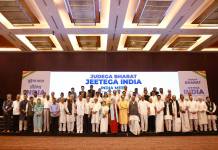Prime Minister Narendra Modi is known for many things, but lack of confidence is not one of them. In fact he is someone, who often comes across as an individual too sure of the eternity of his power. His targets and rhetoric have also reflected how he believed that in light of the massive mandate he received in 2014, 2019 was also a done deal.
So when Modi talked about not being afraid to loose power, it left many startled, to say the least. Things surely were changing when the PM, who behaved as if he had been made emperor for life, started talking about quitting.
The change in Modi’s temper is not without a reason. Demonetisation, his biggest gamble, is going horribly wrong. The monumental mismanagement (not printing enough replacement currency, the new notes not having the desired security features due to uncalled for haste and the ATM’s not being configured for new notes, to name just a few) has virtually floored the flying Indian economy.
From being one of the fastest growing economy, ours has now become one of the fastest slowing economy. None of the stated aims have been remotely achieved. Against initial claims of over three lakh crore of black cash not returning and thereby leading to a bonanza for the government, now less than three lakh crores of old notes remain in the system with 20 days still to go.
The large seizure of new notes used for bribes also punctures claim of the move hitting corruption in any significant manner. The frequent terror activities since the move was implemented makes it clear that the aim of affecting criminal and terror activity was also not meaningfully accomplished.
Realising how unsuccessful the move has been in accomplishing its original motives, now the government has shifted goalposts and is trying to hard-sell it as a move to create a cashless economy. But in the absence of widespread digital literacy, adequate smartphone penetration, awareness of security threats and precautions, poor electricity supply in most areas and adverse usage charge, the government doesn’t seem to be fairing well even on this narrative either. Thus, a dispassionate analysis of demonetisation is likely to show, sooner than later, that it is a disaster of unmatched proportion that has been inflicted due to whimsical headline grabbing attitude of Narendra Modi.
The fear of people gradually realizing this has been aggravated by a few other factors that are threatening to make demonetisation a sort of Waterloo for Modi. What are these factors that can make demonetization the beginning of the end of Modi regime?
BJP’s ploy to exploit class resentment coming undone
A significant reason for the support of the move had been its pitch to make the rich black money holders suffer. This was a clever ploy by BJP to tap into class resentment to boost support for the move. But while the pitch gained initial traction, it is now coming undone as the sell of the move shifts from black money to cashless economy.
Firstly, the satisfaction and support of the masses due to the rich black money hoarders suffering from move didn’t prove to be true with the resourceful finding workarounds to and convert most of their black cash to white.
Secondly, an abrupt shift to cashless economy will make the less educated and less digitally savvy loose out compare to the well-off, who already have the infrastructure for cashless operations, again undermining the pitch that the move favours the David’s against the Goliath.
Thirdly, that the burden of the humiliating and exhausting wait in the unending queues has inordinately been borne by the poor, is not something people are going to forget that easily.
BJP’s core vote bank worst hit
The move has substantially affected trading and led to steep decline in revenue for the traders and merchants, who constitute the core vote bank of BJP. Secondly, in it’s messaging around demonetisation, traders and merchants were made to appear as the principal culprits, which even if true, is unlikely to be taken kindly by the traders (No one, not even a dishonest person, like to be painted as dishonest in public). Thirdly, the forced transition to cashless transaction is going to create huge transition cost (economical as well as psychological) for the trading class, further deepening the resentment that BJP is likely to encounter among them.
A troubled relation with its core vote bank, which is also a significant source of donations, is the last thing any party facing crucial elections can wish for.
Rural India reeling under two consecutive droughts has been left scarred
Ever since Modi came to power, he had a troubled relationship with rural India. Two consecutive droughts have led to the slowest growth in farming income in over a decade. He also lost a costly battle over land acquisition bill. But with the above normal monsoon this time, Modi government had a golden opportunity to gain lost ground in rural India. But with demonetisation hitting rural India hard, leave alone gaining any lost ground, trouble brews in the hinterland for Modi.
The demonetisation decision is particularly ill timed from the perspective of rural economy as this was a crucial time in farming cycle and the absence of cash has hit farmers in untold ways- problems with purchase of seeds and fertilisers, reduced selling of produce, etc.
Confidence in Modi’s political and economic competence dented
Modi rode to power on the back of a large-scale belief in his economic competence. Growth has been Modi’s trump card that has allowed him to win many elections. But demonetisation is turning out to be such an economic catastrophe, that it’s unlikely that belief in Modi’s economic competence will ever be the same, thus proving to be a permanent liability that the prime minister may find hard to overcome.
Also Modi’s politics has been built on selling strong leadership, which was particularly appealing to a populace fed up with the weak leadership of UPA 2. With the populace reeling under the burden of a move which was a result of the same quality, Modi will not find many takers for his kind of “strong leadership”.
Modi’s global image has nosedived
If the domestic coverage of demonitisation has been somewhat divided, the global opinion, free from the clutches of the influences that ruling regime has on domestic opinion through various channels, is sharply critical of the move. The top global dailies have slammed the move and wondered as to how Modi has survived this disaster.
There is little doubt that with demonetisation, Modi’s global image has totally nosedived. The note ban has completed the disillusionment that has been breeding due to the slower than expected pace of reform and increasing social strife under Modi’s regime.
This loss of global confidence in Modi will imply lower investor’s confidence in India (which is also due to instability and lower growth rate in the aftermath of demonitisation) thereby hampering Modi’s ability to accomplice his growth agenda. Also the loss of credibility in Modi will make his interactions with global leaders less favorable for India.
The factors above create a strong ground for Modi to fear that demonetization may prove to be his Waterloo moment. It could have already created much more trouble had the opposition been less fragmented, more skillful, had greater credibility and mobilised better.
Also the present level of resentment has been far less than what it would have been normally there due to BJP’s brilliant messaging and very active media management on all mediums and platforms. But the propaganda can take you only so far.
Sooner or later BJP will learn that you can fool some people all the time, all the people some time but not all the people all the time. When that reckoning dawns on BJP, it may learn, perhaps too late to do anything about it, that demoitisation has set in motion the beginning of the end of Modi regime.
















